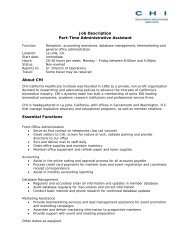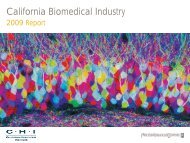California Biomedical Industry - California Healthcare Institute
California Biomedical Industry - California Healthcare Institute
California Biomedical Industry - California Healthcare Institute
Create successful ePaper yourself
Turn your PDF publications into a flip-book with our unique Google optimized e-Paper software.
time that wireless technologies can helpone patient and his or her physicianmanage the individual’s health, theycan be contributing new data to betterdescribe the symptoms, managementand outcomes for the entire populationof patients with that condition. A socialmedia company based in Cambridge,Mass. — Patients Like Me — iscompiling integral data from patientpopulations globally toward betterresearch and management of a longlist of prevalent and rare diseases. Theorganization also connects patients toone another and to information andresources to help them manage theirconditions.Another area that is being equippedwith wireless technologies is sleepdisorders. Topol said, “Tens of millionsof people are living with undiagnosedsleep disorders,” conditions thathave been linked with poor workperformance, driving accidents,relationship problems, and moodproblems like anger and depression.Chronic sleep loss also has been shownto increase the risk of heart disease,diabetes and obesity. Currently, to bediagnosed, many patients check into“sleep labs,” where they are fitted withmonitors to measure such metrics asbrain activity, heart activity, changes inblood pressure, and blood oxygen levels.They sleep a night at the facility to bediagnosed and then again to monitorthe therapy.“We could, today, attach a sleep sensorto your phone,” Topol said, “which youcould sleep with in your own bed, whereyou’re going to sleep most normally.”The device would record the metricsnecessary to diagnose sleep disorders.As with any disruptive technology,however, there are challenges tocommercializing wireless technologies.One, Topol said, is that the medicalcommunity is very resistant to change.It takes time to learn and trust newtechnologies enough to recommendthem to patients, time that cliniciansmay not have.Another issue concerns reimbursement.In the sleep disorders example, theability of prospective patients toadminister their own diagnostics intheir own homes would immediatelyand significantly reduce the demand forservices at specialized sleep clinics.Topol, a cardiologist, has seentechnology’s effect on his own practice.In February 2010, GE introduced apocket-sized ultrasound device. CalledVscan, it produces high-resolutionvideos of the heart in minutes. Topolsaid that he uses the Vscan with all ofhis patients and has markedly reducedthe number of full echocardiograms heorders.The latter, a “full echo,” is a test thatcosts more than $1,500, takes 40 to45 minutes to perform, and requiresan appointment and return visit. Eachfull scan that is not required “costs”the physician a share of the diagnosticfee and an added patient visit. Yet 8million heart echoes are done yearly inthe United States at a combined cost ofwell over $10 billion. “If we can cut thatat least 10 percent to 20 percent,” Topolsaid, “it has enormous potential.”In other indications, Centers forMedicare & Medicaid Services (CMS)reimbursement parameters wouldhave to be adapted to compensatefor wireless devices. Complicationsin getting reimbursed could delayphysician and/or patient interest in thenew products.Topol said that while there is ashorter development time betweendiscovery and filing for FDA approvalwith wireless technologies than withpharmaceutical products or implantabledevices, the process remainscomplicated. “Part of the challenge isthat there are no studies yet to provethat wireless glucose monitoringimproves health or saves lives,” he said.The sector has the added complexityof also having to satisfy FederalCommunications Commission (FCC)requirements.Another challenge is the lack ofstandards and coordination across thesector. Ideally, wireless technologieswould all be aggregated on one’sphone. Otherwise, patients could findthemselves hooked up to multiplemonitoring devices, which would becumbersome.“All of these challenges aresurmountable,” Topol said. “And if thetechnology helps people and lowerscosts, it’s just a matter of time before itis adopted.”Topol said that wireless access,the Internet and the growth ofsocial networking have made oursa consumer-centric world. Today’spatients have access to and are morelikely to seek out information abouttheir conditions. With that knowledgeand involvement comes demand forbetter, more effective therapies andmore access to them.“From the time that the first clotdissolving agent for stroke victims wasproven to work, it took more than sevenyears for it to be used in patients,” Topolsaid. “Patients’ tolerability for waitinghas completely changed.”“The next couple of years will put us ina powerful position,” Topol said of theWest Wireless Health <strong>Institute</strong>, whichwas founded in 2009 in La Jolla, andthe wireless health technology industryin <strong>California</strong>. “There are literally morethan 100 wireless companies in SanDiego alone,” he said. A leader amongthem is Qualcomm. Silicon Valleypillars such as Dell and Google arepotential partners as well.“We would love to work with Apple,”Topol said. He suggested that patientsmay one day use devices like Apple’shandheld wireless iPad to download andstudy their own X-rays, ultrasounds,and other imagery.Given the life- and health-improvingbenefits, the cost-cutting potentialsand innovation’s ability to spawnnew breakthroughs, Topol knows theconversation has only just begun.<strong>California</strong> <strong>Biomedical</strong> <strong>Industry</strong> 2011 Report | 51






